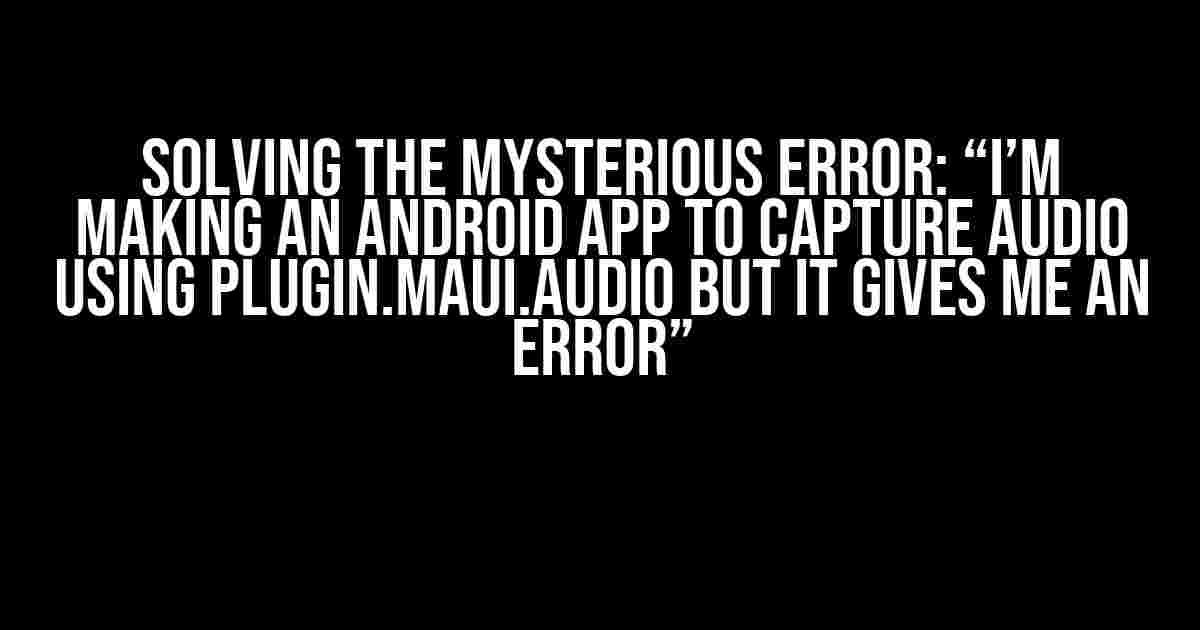Are you tired of scratching your head, wondering why your Android app is refusing to capture audio using the Plugin.Maui.Audio? Do errors and exceptions have you stuck in a never-ending loop of frustration? Fear not, brave developer! In this article, we’ll delve into the world of audio capturing, diagnose the issue, and provide a step-by-step solution to get your app up and running smoothly.
Understanding the Plugin.Maui.Audio
The Plugin.Maui.Audio is a powerful plugin that enables you to access and manipulate audio functionalities in your Android app. It provides a simple and intuitive way to record and play audio, making it a popular choice among developers. However, like any other plugin, it’s not immune to errors and issues.
The Error: A Closer Look
When you encounter an error while using the Plugin.Maui.Audio, it’s essential to understand the root cause of the problem. Here are some common error messages you might see:
Error: Android.Runtime.Java.Lang.RuntimeException: 'java.lang.RuntimeException: Unable to get microphone'Error: Plugin.Maui.Audio.AudioService Exception: 'audioRecord initialization failed'Error: Permission denied: recording audio
The error messages above might seem cryptic, but don’t worry, we’ll break them down and provide solutions to each one.
Solution 1: Grants Permissions and Configure AudioRecord
The first step in resolving the error is to ensure your app has the necessary permissions to access the device’s microphone. You’ll need to add the following lines to your AndroidManifest.xml file:
<uses-permission android:name="android.permission.RECORD_AUDIO" /> <uses-permission android:name="android.permission.MODIFY_AUDIO_SETTINGS" />
Next, you’ll need to configure the AudioRecord settings to match your app’s requirements. Here’s an example:
var audioRecord = new AudioRecord(
AudioSource.Mic,
SampleRate.Hz44100,
ChannelCount.Monochannel,
AudioFormat_PCM_16BIT,
BufferSize
);
Make sure to adjust the SampleRate, ChannelCount, and AudioFormat properties according to your app’s needs.
Solution 2: Request Runtime Permissions
In Android 6.0 (API level 23) and later, you need to request runtime permissions to access the device’s microphone. You can do this by adding the following code:
var permissionStatus = await CrossPermissions.Current.CheckPermissionStatusAsync(Permission.Microphone);
if (permissionStatus != PermissionStatus.Granted)
{
await CrossPermissions.Current.RequestPermissionsAsync(Permission.Microphone);
}
This code checks if the app has been granted permission to access the microphone. If not, it requests permission from the user.
Solution 3: Initialize AudioService Correctly
Another common issue arises when initializing the AudioService incorrectly. Make sure to call the InitializeAsync method before using the audio recording functionality:
await AudioService.InitializeAsync();
This initializes the AudioService and prepares it for use in your app.
Solution 4: Handle AudioRecord Exceptions
Sometimes, the AudioRecord initialization might fail due to various reasons, such as:
- Insufficient buffer size
- Invalid audio format
- Device not supported
To handle these exceptions, you can use a try-catch block to catch and log the error:
try
{
audioRecord.StartRecording();
}
catch (Java.Lang.RuntimeException e)
{
Console.WriteLine($"Error: {e.Message}");
}
Solution 5: Check Android Version and Device Compatibility
Some devices or Android versions might have issues with the Plugin.Maui.Audio. To mitigate this, you can:
- Check the Android version and device compatibility before initializing the AudioService
- Use alternative audio recording libraries or plugins
Here’s an example of how to check the Android version:
if (Android.OS.Build.VERSION.SdkInt >= Android.OS.Build.VERSION_CODES.M)
{
// Initialize AudioService
}
else
{
// Handle incompatible devices or Android versions
}
Putting it all Together
By following these solutions, you should be able to resolve the errors and successfully capture audio using the Plugin.Maui.Audio in your Android app. Here’s a summary of the steps:
- Grant necessary permissions in AndroidManifest.xml
- Configure AudioRecord settings
- Request runtime permissions (Android 6.0 and later)
- Initialize AudioService correctly
- Handle AudioRecord exceptions
- Check Android version and device compatibility
Remember to adapt these solutions to your specific app requirements and handle any additional errors that might arise.
Conclusion
With these solutions in hand, you should be able to overcome the mysterious error and successfully capture audio using the Plugin.Maui.Audio in your Android app. Remember to stay patient, persistent, and creative in your problem-solving endeavors. Happy coding!
| Solution | Description |
|---|---|
| Grant Permissions | Add necessary permissions in AndroidManifest.xml |
| Configure AudioRecord | Set AudioRecord settings to match app requirements |
| Request Runtime Permissions | Request microphone permission from user (Android 6.0 and later) |
| Initialize AudioService | Call InitializeAsync method before using audio recording functionality |
| Handle AudioRecord Exceptions | Catch and log errors during AudioRecord initialization |
| Check Android Version and Device Compatibility | Check device and Android version compatibility before initializing AudioService |
Frequently Asked Question
Got stuck with your Android app audio capturing using plugin.maui.audio? Don’t worry, we’ve got you covered!
What is plugin.maui.audio and why am I getting an error?
Plugin.maui.audio is a plugin that allows you to access the device’s audio capabilities in your Android app. The error you’re experiencing could be due to various reasons such as incorrect plugin configuration, missing permissions, or conflicting dependencies. Make sure to check your plugin configuration, AndroidManifest.xml file, and dependencies to troubleshoot the issue.
How do I add the plugin.maui.audio to my Android project?
To add the plugin.maui.audio to your Android project, you need to install the nuget package Maui.Audio. Right-click on your project in Visual Studio, select “Manage NuGet Packages,” search for Maui.Audio, and install the package. Then, add the plugin to your MainActivity or the activity where you want to capture audio.
What permissions do I need to add to my AndroidManifest.xml file for audio capturing?
To capture audio, you need to add the RECORD_AUDIO permission to your AndroidManifest.xml file. You can do this by adding the following line of code: `
How do I initialize the audio recorder using plugin.maui.audio?
To initialize the audio recorder using plugin.maui.audio, you need to create an instance of the AudioRecorder class and set the audio source, format, and output file. Here’s an example: `var audioRecorder = new AudioRecorder(); audioRecorder.AudioSource = AudioSource.Mic; audioRecorder.OutputFileType = OutputFileType.WAV; audioRecorder.OutputFile = “path/to/output/file.wav”;`. Then, call the `StartRecording` method to start capturing audio.
What are some common errors I might encounter while using plugin.maui.audio, and how do I troubleshoot them?
Common errors you might encounter while using plugin.maui.audio include permission denied, audio format not supported, or recorder not initialized. To troubleshoot these errors, check your AndroidManifest.xml file for the correct permissions, verify that the audio format is supported, and ensure that the audio recorder is properly initialized. You can also check the plugin’s documentation and GitHub issues for more information on troubleshooting common errors.



